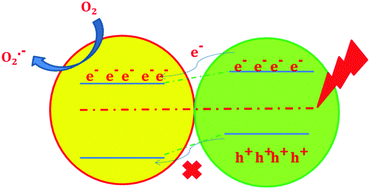Preformed ZnS nanoflower prompted evolution of CuS/ZnS p–n heterojunctions for exceptional visible-light driven photocatalytic activity†
Abstract
In this report, CuS/ZnS heterojunctions were obtained through ion-exchange between as-prepared ZnS nanoflowers (synthesized using a modified hydrothermal route) and copper(II) sulfate in an aqueous solution. Then, the as-prepared CuS/ZnS heterojunctions prompted exceptional visible-light driven (λ ≥ 400 nm) photocatalytic activity, which surpasses almost all the reported ones. The photocatalyst performs best when a particular ratio of CuS and ZnS is maintained during the synthesis. This is observed at the ratio where CuS anchors onto the pre-formed ZnS, and gives rise to an effective heterojunction, which is found to be capable of degrading cationic dyes (such as methylene blue, crystal violet, and malachite green) within 120 s under visible-light exposure. Furthermore, the efficiency of the photocatalyst is preserved up to the 4th cycle of operation without any photo-corrosion. The dramatic enhancement in the visible-light photocatalytic performance of the CuS/ZnS heterojunctions over pure ZnS and CuS can be attributed to the effective electron–hole separation at the interfaces of the two semiconductors due to the formation of a superior heterojunction between the n-type semiconductor, ZnS, and p-type semiconductor, CuS, which facilitates the interfacial transfer of photoinduced carriers. The CuS loading onto ZnS is crucial to make the composite exceptionally photoactive for fast kinetics, which leads to prompt waste water treatment. The present study provides a new avenue to gain in-depth insight to the design of a highly efficient photocatalyst with heterojunctions.


 Please wait while we load your content...
Please wait while we load your content...